Abstract
Liquid hydrogen (LH2) is a promising energy carrier to decrease the climate impact of aviation. However, the inevitable formation of hydrogen boil-off gas (BOG) is a main drawback of LH2. As the venting of BOG reduces the overall efficiency and implies a safety risk at the airport, means for capturing and re-using should be implemented. Metal hydrides (MHs) offer promising approaches for BOG recovery, as they can directly absorb the BOG at ambient pressures and temperatures. Hence, this study elaborates a design concept for such an MH-based BOG recovery system at hydrogen-ready airports. The conceptual design involves the following process steps: identify the requirements, establish a functional structure, determine working principles and combine the working principles to generate a promising solution.
1. Introduction
Hydrogen is a promising energy carrier to enable sustainable transportation for long-haul routes. In the aviation sector in particular, hydrogen is an increasingly investigated fuel option, especially in its liquid form [1]. However, many challenges regarding its storage or handling still have to be solved to successfully utilize liquid hydrogen in aircrafts and at airport infrastructures. One major challenge is the inevitable formation of hydrogen boil-off and the corresponding losses when this BOG is vented. These hydrogen losses reduce the overall efficiency of the LH2 supply chain and any exposure implies a safety risk at the airport [2,3]. Moreover, the release of hydrogen to the ambient would partially offset the climate benefit of savings in CO2 emissions, as hydrogen indirectly influences global warming [4]. Hence, means for capturing and re-using the BOG should be implemented [5,6,7,8]. Besides the extensive effort of installing pipelines underneath the airport’s apron to recover the boil-off losses, an infrastructure-independent system based on metal hydrides (MHs) could be a promising alternative [9,10]. While MHs are the most compact and safest state to store hydrogen, they can also directly absorb gaseous hydrogen (GH2) at ambient pressures and temperatures [11]. When subsequently increasing the MH’s temperature, e.g., by using the waste heat of a fuel cell (FC), the hydrogen can be released at a higher pressure to be directly supplied to the FC [12].
The goal of this study is to conceptualize a BOG recovery system that utilizes the aforementioned advantageous properties of MHs. In contrast to an infrastructure-demanding pipeline-based recovery system, the concepts rely on multiple, exchangeable MH cartridges, which are used in a circulating manner. Firstly, fundamentals of LH2 handling are described, and the state-of-the-art of MH-based BOG recovery is presented in the following section. Subsequently, the methodology of the conceptual design phase is briefly introduced before the design process is conducted and the results are combined into a design proposal.
2. LH2 Handling and Boil-Off
2.1. Review of LH2 Handling at Airports
Venting is the process of releasing hydrogen vapor from the LH2 tank once it has reached its maximum allowable pressure [3]. Reasons for pressure rise are displacement of the GH2 during refilling or hydrogen evaporation due to heat input into the cryogenic tank. Although vented hydrogen gas can be ignited and burned safely at a venting nozzle, the corresponding flare stacks need to be distanced 60 m from any occupied building [3]. This procedure results in limitations in an airport environment, which may lead to no-venting regulations in the first phases of LH2 operations at airports [3].
Two possible scenarios to transfer hydrogen from storage facility of the airport to the aircraft are a distribution by bowser trucks and a supply by a pipeline dispenser system [5,9]. While the pipeline system allows the recovery of BOG, the distribution by trucks offers higher flexibility [9]. In future airport operation, there will be a trade-off between bowser distribution, with its low capital costs and higher operational costs, and a pipeline dispenser system, with its high capital costs and lower operational costs [5]. As the potentially higher boil-off losses of the bowser distribution are not favorable, additional devices for BOG recovery are hence recommended for the trucks to enhance the efficiency of the supply chain and to decrease the financial loss from BOG venting [5,7].
During the different phases of the refueling process, the boil-off rate differs as there are different sources which trigger the evaporation [6,9,11]. Although some phases like cooling down the hoses or depressurizing the bowser’s vessel generate short bursts of GH2, the boil-off rate is nonetheless fairly constant during the whole refueling process of approximately 30 min [5,6,11]. The amount of BOG that needs to be vented strongly depends on the specific filling process and on the applied means of mitigation [6,9]. Despite these uncertainties, Mangold et al. proposed a hydrogen capacity of 50 kg for a boil-off recovery system onboard of a refueling truck [5]. Compared to the total mass of a trailer for transporting fossil fuels of typically 34 tons, an LH2-trailer exhibits a lower total mass of approximately 27 tons due to the low density of LH2 [13,14]. This weight margin could be used to integrate a boil-off recovery system into the trailer of the refueling truck.
2.2. Boil-Off Recovery by Metal Hydrides
With their potential ability to absorb hydrogen at low pressure levels, metal hydrides (MHs) can be used to capture, store and compress the BOG released from LH2 tanks for further utilization, as illustrated in Figure 1A [9,11]. When absorbing the BOG, the MH needs to reject the heat of the absorption reaction. On the contrary, a supply of heat is required to drive the release of hydrogen by desorption. The black line indicates the equilibrium pressure of the material in relation to the temperature T. This pressure-temperature-correlation can be utilized to supply the hydrogen at a higher level phigh than the available pressure level plow during the uptake of the BOG. In an exemplary arrangement with a fuel cell (FC) as a consumer, the waste heat of the fuel cell can be sufficient to achieve a desorption pressure high enough for the hydrogen to be directly supplied to the FC. This process of hydrogen compression by waste heat further increases the efficiency of the MH-based BOG recovery beyond the effect of only mitigating the hydrogen losses.

Figure 1.
BOG recovery by MHs: (A) Schematic plot of the working principle of hydrogen compression by MHs from low-pressure LH2; (B) Scenario of MH cartridges at airports.
Several studies highlight the potential of MHs for BOG recovery [11,15]. Fuura et al. developed an on-board MH system to capture the boil-off losses that result over time from heat leakage between LH2 tank and ambient atmosphere for example during parking periods [15]. To absorb the corresponding relatively low hydrogen mass flow, the cooling by natural convection with the ambient air proved to be sufficient. In another study, Rosso et al. not only demonstrated the capture but also the subsequent compression of low-pressure GH2 [11]. By achieving rapid absorption rates with the help of forced liquid cooling, they validated that MHs are also suited to capture the typically higher mass flow rates of BOG which occur during LH2 refueling. In addition to these scientific studies, there are several patents that describe the use of MHs or other hydrogen absorbents to handle BOG [16,17,18,19,20,21]. Although all these publications illustrate various ways to successfully recover boil-off losses with MHs by capturing, storing and compressing, each of these systems is dedicated to a single, specific application, which results in the following limitations:
- No trans-sectoral use is considered, like BOG capture from an aircraft’s LH2 tank and a subsequent consumption in a ground-based vehicle;
- Limited to narrow operation windows and therefore not suited for varying pressure levels of different boil-off sources and several potential consumers;
- No mobile use is intended to enable distribution or intermediate hydrogen storage according to the needs of the processes at the airport.
The goal of this study is to elaborate a conceptual design of a BOG recovery system for the bowser distribution at airports that overcomes these limitations by using exchangeable MH cartridges as illustrated in Figure 1B.
3. Methodology of the Conceptual Design
The design of complex systems is usually supported by methodical design approaches like the VDI guideline 2221, which defines the central objectives, activities, and results of the design process. Such approaches reduce the complexity of a design task by breaking it down into discrete process steps [10,22]. Figure 2 depicts the process that is used in this study, and the following subsections present the results of these steps.

Figure 2.
Process steps of the conceptual design in respect to [22].
4. Results of the Conceptual Design
4.1. Requirements
The alloy LaNi4.6Al0.4 is favorable for MH-based BOG recovery as it exhibits fast kinetics and favorable equilibrium pressures with flat plateau slope and low hysteresis [11]. Hence, the derivation of the requirements in Table 1 are based on this alloy. With its usable hydrogen capacity of 1.3 weight percent, an amount of approximately 150 kg of LaNi4.6Al0.4 will be required to store 2 kg of hydrogen. Considering a weight ratio of 1:1 for the MH material weight to the empty cartridge weight, the total cartridge weight adds up to 300 kg [23]. Based on an alloy density of 7.44 kg/l and a packing density of 60%, the volume results in approximately 35 liters [11,24]. This leads to a characteristic nature of the MH cartridges to be compact but heavy.

Table 1.
Excerpt from the requirements list of the boil-off recovery system.
4.2. Functional Structure Tree and Corresponding Working Principles
The illustration of a functional structure of a system helps to identify the required physical processes, components, and relationships [22]. Figure 3 depicts the functional structure tree of the BOG system with main functions and a first level of subfunctions.
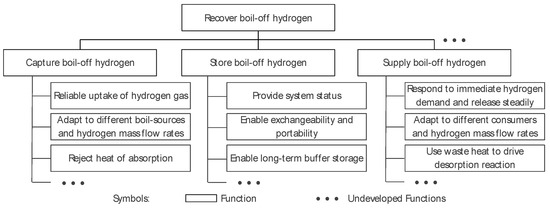
Figure 3.
Functional structure tree of the BOG recovery system with main and subfunctions.
Based on the functional structure tree, the scope of the conceptual design of this study is framed with the help of Figure 4. In addition to defining the designated application areas of the BOG recovery system, this illustration highlights the main subsystems with their tasks and elements. For these subsystems, potential working principles are elaborated in the following subsections.
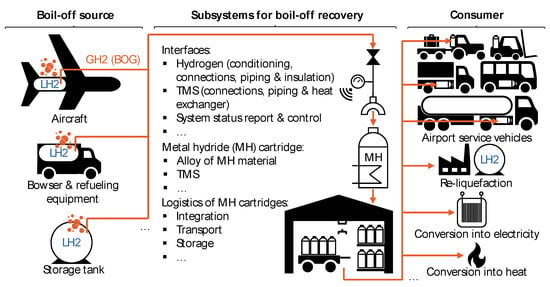
Figure 4.
Overview of the potential subsystems involved in the BOG recovery process.
4.2.1. Interface Design Proposals
Generally, an MH vessel consists of a gas-proof containment in which the MH material is placed, of a thermal management system (TMS) with a heat transfer fluid (HTF) to remove or supply the reaction heat and of means for input, output, and the distribution of hydrogen [10,27]. The interfaces of the cartridge are schematically illustrated in Figure 5.
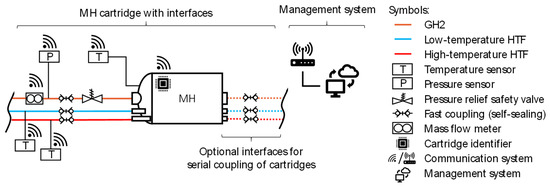
Figure 5.
Essential interfaces of the cartridges and overarching management system for control.
4.2.2. Design Proposals for the TMS of the MH Cartridge
While there are various ways to remove and to supply the reaction heat, the use of liquids, such as water–glycol mixtures, or air as a heat transfer fluid (HTF) is a common solution [27]. Figure 6 presents the TMS principles, which are considered for the heat transfer out of and into the MH cartridge.
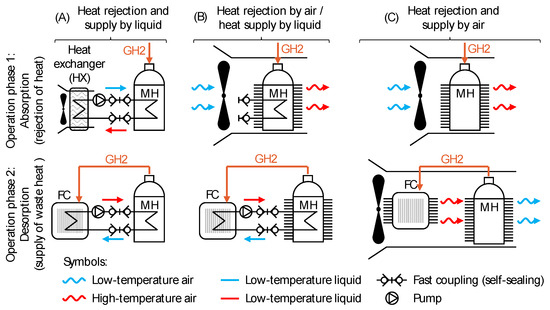
Figure 6.
Potential TMS interfaces (A–C) for heat transfer out of/into the MH cartridge.
Although Figure 6 depicts fans to drive the airflow, both convection types, natural and forced, may be used. However, natural convection only allows low specific absorption and desorption rates [28,29]. For higher hydrogen mass flows, for example, the boil-off losses during refueling operations, slow specific desorption rates would lead to unreasonable system sizes as large amounts of MH material would be required. The use of natural convection is especially challenging for the BOG recovery application with its operating conditions close to the MH material’s equilibrium conditions.
Although forced air convection is more effective than natural convection [30], it is expected to be more limiting in terms of implementation than the heat transfer by liquids. Firstly, consumers with air-cooled PEMFCs will be required to provide a heat supply by air. However, liquid cooling is the most common cooling method for FCs with more than 5 kW of power [31]. Secondly, for heat supply by air, the MH cartridges require external fins and have to be installed in the cooling air ducts of the PEMFCs, which will lead to limitations regarding potential consumers due to design space restrictions. For waste heat transfer by liquid media, the positioning of the MH cartridges is less restricted, as the HTF lines could be placed more versatilely.
Based on the hydrogen mass flow , the reaction enthalpy , and the molar mass of hydrogen , the heat of reaction can be calculated as follows:
The target absorption time from Table 1 and the corresponding hydrogen mass flow lead to a power requirement for the heat rejection of a single cartridge of 20 kW. This cooling power demand would lead to unreasonably large dimensions of external fins for heat rejection by air, especially in hot day conditions when the temperature difference for heat rejection becomes low. A respective heat transfer coefficient of natural convection of 5 W/(m2K) and a temperature difference of 5 K would lead to an external fin area requirement of 800 m2 [30]. As the heat transfer coefficient of liquid cooling is two orders of magnitude higher, its area requirement is correspondingly smaller. Hence, liquid heat transfer is recommended to not deteriorate the compact nature of the MH cartridges.
4.2.3. Proposals for MH Cartridge Logistics
Potential locations for the cartridges during BOG capture are shown in Figure 7. Although option (A) enhances flexibility between actual BOG rates and hydrogen demands by connecting the MH cartridges to the GH2 grid, this solution requires higher infrastructure demands and thereby offsets the benefits of bowser distribution. Hence, it may be beneficial to use option (B) or (C) in combination with only a single, separate facility for intermediate storage. This intermediate storage acts as a buffer during times with high amounts of boil-off and low hydrogen demand from consumers or vice versa. A connection to the GH2 grid enables refilling the MH cartridges or deploying the hydrogen into the grid. Option (C) may be more beneficial compared to (B), as the systems of the truck could be used to supply electrical power for sensors, communication, or to drive the HTF pump. As described in Section 2.1, the LH2 trailer offers a weight margin of approximately 7 tons that can be used for the integration of the cartridges and further subsystems. However, the hydrogen capacity of 50 kg suggested by Mangold et al. could not be fully achieved by retrofitting a conventional LH2 trailer, as this capacity would require 25 cartridges in total, which leads to a total cartridge weight of 7.5 tons. Nevertheless, the mismatch may be solved by modifying the LH2 trailer or by slightly reducing the total capacity of the recovery system. However, option (B) can still be promising as it offers high independence and flexibility. Especially for lower hydrogen mass flow rates, when natural convection is sufficient to reject the heat of absorption, this positioning can be beneficial.

Figure 7.
Potential positioning of MH cartridges during LH2 refueling.
4.3. Combination of Working Principles to a Design Concept
Based on the description of the working principles, the most promising ones are combined with the design concept illustrated in Figure 8. Depending on the boil-off source, the use of two different TMS interfaces is proposed for the BOG capture. To meet the high BOG mass flow rates during LH2 refueling, liquid cooling is applied to meet the demands for powerful heat rejection. Thus, the positioning according to Figure 7 option (C) is proposed as the additional systems of the TMS, like heat exchangers with fans and HTF pumps, could be supplied with electrical power from the truck. For low boil-off rates, on the other hand, natural convection may be sufficient. For example, when the aircraft is out of operation and exceeds its dormancy time, which is the time span until the internal pressure reaches the venting pressure. The use of passive natural cooling can be beneficial in this case, as infrastructure and power supply demands will be minor, allowing for more flexible positioning of the cartridges. As illustrated, the external fins for the heat rejection to the ambient air are not part of the cartridge, as permanently attached fins would lead to high space demands in all other subsystems and are prone to damage during handling. In the consumer subsystem, however, only the use of liquid as HTF is proposed due to the limitations of air, which have been described in Section 4.2.2. Referring to the buffer storage, a connection to the hydrogen grid ensures refilling of the cartridges when the occurring boil-off rates are too low to cover the demands of the consumers. On the contrary, hydrogen can also be fed back to re-liquefaction or converted into heat or electricity for stationary use when the boil-off rates exceed the demands of the consumers.
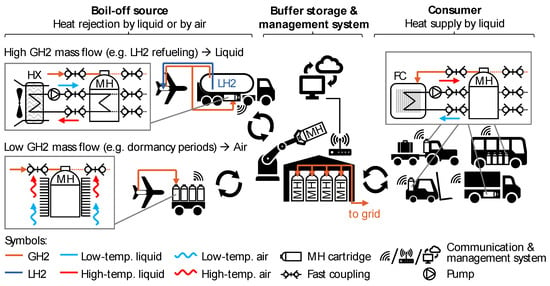
Figure 8.
Proposed design concept for boil-off recovery at airports by MH cartridges.
5. Conclusions
As the overview of the state-of-the-art examples of boil-off gas (BOG) recovery by metal hydrides (MHs) already emphasizes the general feasibility and reasonability of this technology, this study provides a conceptual design that uses exchangeable MH cartridges to enable trans-sectoral application. At first, the requirements were identified, and a functional structure tree was established before corresponding working principles were determined. Finally, the most promising principles were combined into a design concept proposal for BOG recovery at airports. In upcoming studies, further concepts should be derived from the working principles and subsequently evaluated and benchmarked. Moreover, a proof of concept by experiments based on a small-scale demonstrator is recommended to verify the operation range, to explore potential improvements like alternative MH alloys with higher storage densities, and to identify the electrical power demands of additional systems like pumps and fans. However, the proposed concept already reveals the huge potential of exchangeable MH cartridges to empower future sustainable aviation and to enhance the efficiency of the LH2 supply chain in general. As this concept is not limited to aviation, further markets, such as maritime infrastructures or the automotive sector, should be addressed to achieve a high market penetration.
Author Contributions
Conceptualization, F.F. and S.K.; methodology, F.F. and S.K.; formal analysis, F.F.; investigation, F.F.; writing—original draft preparation, F.F.; writing—review and editing, F.F and S.K.; visualization, F.F.; supervision, S.K.; project administration, F.F.; funding acquisition, S.K. All authors have read and agreed to the published version of the manuscript.
Funding
This research received no external funding.
Institutional Review Board Statement
Not applicable.
Informed Consent Statement
Not applicable.
Data Availability Statement
No new data were created or analyzed in this study. Data sharing is not applicable to this article.
Acknowledgments
We wish to acknowledge Inga Bürger for her ongoing advice and sharing her profound knowledge and also Georg Pohl for his support in the brainstorming and research.
Conflicts of Interest
The authors declare no conflicts of interest.
References
- Baroutaji, A.; Wilberforce, T.; Ramadan, M.; Olabi, A.G. Comprehensive Investigation on Hydrogen and Fuel Cell Technology in the Aviation and Aerospace Sectors. Renew. Sustain. Energy Rev. 2019, 106, 31–40. [Google Scholar] [CrossRef]
- Stephan, T.; Breiteneder, T.; Winklhofer, J. Comparison of Liquified Gas Energy Carriers and Conventional Fossil Fuels with a Focus on Storage Requirements for the Use in Mobile Applications. In Proceedings of the Vienna Motor Symposium, Vienna, Austria, 26–28 April 2023. [Google Scholar]
- Huete, J.; Pilidis, P. Parametric Study on Tank Integration for Hydrogen Civil Aviation Propulsion. Int. J. Hydrogen Energy 2021, 46, 37049–37062. [Google Scholar] [CrossRef]
- Warwick, N.; Griffiths, P.; Keeble, J.; Archibald, A.; Pyle, J.; Shine, K. Atmospheric Implications of Increased Hydrogen Use; Department for Energy Security and Net Zero and Department for Business, Energy & Industrial Strategy: London, UK, 2022. Available online: https://www.gov.uk/government/publications/atmospheric-implications-of-increased-hydrogen-use (accessed on 27 April 2022).
- Mangold, J.; Silberhorn, D.; Moebs, N.; Dzikus, N.; Hoelzen, J.; Zill, T.; Strohmayer, A. Refueling of LH2 Aircraft—Assessment of Turnaround Procedures and Aircraft Design Implication. Energies 2022, 15, 2475. [Google Scholar] [CrossRef]
- Petitpas, G. Boil-Off Losses Along LH2 Pathway; LLNL-TR-750685; LLNL: Livermore, CA, USA, 2018.
- Brewer, G.D. Hydrogen Aircraft Technology, 1st ed.; CRC Press LLC: Boca Raton, FL, USA, 1991. [Google Scholar]
- Turner, J.; Contaut, S.; Tarantino, A.; Masson, A. FlyZero: Cryogenic-Hydrogen-Fuel-System-and-Storage-Roadmap-Report; Aerospace Technology Institute: Cranfield, UK, 2022; Available online: https://www.ati.org.uk/flyzero-reports/ (accessed on 25 July 2022).
- Franke, F.; Kazula, S.; Enghardt, L. Elaboration and Outlook for Metal Hydride Applications in Future Hydrogen-powered Aviation. Aeronaut. J. 2024, 128, 1501–1531. [Google Scholar] [CrossRef]
- Pohl, G. Konzeptentwicklung zum Auffangen und Verwerten von Gasförmigen Wasserstoffverlusten aus dem Boil-Off von Flüssigwasserstofftanks Durch Metallhydrid. Bachelor’s Thesis, BTU Cottbus-Senftenberg, Cottbus, Germany, 2024. [Google Scholar]
- Rosso, M.J.; Golben, P.M. Capture of Liquid Hydrogen Boiloff with Metal Hydride Absorbers; NASA CR 83098; John F. Kennedy Space Center: Merritt Island, FL, USA, 1984.
- Kölbig, M.; Bürger, I.; Linder, M. Characterization of Metal Hydrides for Thermal Applications in Vehicles below 0 °C. Int. J. Hydrogen Energy 2019, 44, 4878–4888. [Google Scholar] [CrossRef]
- Feldbinder Spezialfahrzeuge. Liquid Tank Semi-Trailer. Available online: https://www.feldbinder.com/en/liquid-tank-semi-trailers-for-hazardous-goods__100/ (accessed on 5 July 2024).
- Cryolor. Storage & Transport of Liquid Hydrogen. 2024. Available online: https://www.cryolor.com/sites/cryolor/files/2024-06/cryolor-lh2-brochure-01-24.pdf (accessed on 5 July 2024).
- Fuura, T.; Tsunokake, S.; Hirotani, R.; Hashimoto, T.; Akai, M.; Watanabe, S.; Enoki, H.; Akiba, E. Development of a LH2 Vehicle Tank Boil-off Gas Recovery System Using Hydrogen Storage Alloys. In Proceedings of the World Hydrogen Energy Conference, Yokohama, Japan, 27 June–2 July 2004. [Google Scholar]
- Schneider, C.; Svens, P.; Sjödin, R. Hydrogen Storage Arrangement. Swedish Patent SE 2150460 A1, 15 November 2022. [Google Scholar]
- Fujitani, S.; Nishimura, K.; Nishio, K.; Sato, K.; Yonezu, I. System-for-Storing-and-Utilizing-Hydrogen. U.S. Patent 5,728,483, 17 May 1998. [Google Scholar]
- Wang, T.C.; Morris, W.; Siegfried, J.P.; Du, J.J.; Verploegh, R.J. Liquefied Gas System with Boil-off Capture. International Patent WO 2023/225343 A2, 23 November 2023. [Google Scholar]
- Hoffmann, J. Operating Gas System for an Underwater Vehicle, Method for Operating Such an Operating Gas System and an Underwater Vehicle Having Such an Operating Gas System. U.S. Patent 9,638,372 B2, 2 May 2017. [Google Scholar]
- Friedrich, T. Einrichtung zur Druckerhöhung für Wasserstoff. German Patent DE 10 2005 004 590 A1, 10 August 2006. [Google Scholar]
- Masito, S. System for Transforming a Product. International Patent WO 2023/180142 A1, 8 September 2023. [Google Scholar]
- Kazula, S. Variable Pitot-Triebwerkseinlässe für Kommerzielle Überschallflugzeuge: Konzeptstudie Mittels eines Entwicklungsansatzes für Sichere Produkte; Springer Vieweg: Wiesbaden, Germany, 2022. [Google Scholar]
- Bürger, I.; Sourmelis Terzopoulos, V.E.; Kretschmer, C.; Kölbig, M.; Brack, C.; Linder, M. Lightweight Reactor Design by Additive Manufacturing for Preheating Applications Using Metal Hydrides. Int. J. Hydrogen Energy 2021, 46, 28686–28699. [Google Scholar] [CrossRef]
- Hahne, E.; Kallweit, J. Thermal Conductivity of Metal Hydride Materials for Storage of Hydrogen: Experimental Investigation. Int. J. Hydrogen Energy 1998, 23, 107–114. [Google Scholar] [CrossRef]
- Mendelsohn, M.H.; Gruen, D.M.; Dwight, A.E. The Effect of Aluminum Additions on the Structural and Hydrogen Absorption Properties of AB5 Alloys with Particular Reference to the LaNi5-xAlx Ternary Alloy System. J. Less-Common Met. 1979, 63, 193–207. [Google Scholar] [CrossRef]
- SAE. Definition of Commonly Used Day Types, 2023rd ed.; SAE International (AS210): Warrendale, PA, USA, 2023. [Google Scholar]
- Lototskyy, M.V.; Tolj, I.; Pickering, L.; Sita, C.; Barbir, F.; Yartys, V. The Use of Metal Hydrides in Fuel Cell Applications. Prog. Nat. Sci. Mater. Int. 2017, 27, 3–20. [Google Scholar] [CrossRef]
- Davids, M.W.; Lototskyy, M.; Malinowski, M.; van Schalkwyk, D.; Parsons, A.; Pasupathi, S.; Swanepoel, D.; van Niekerk, T. Metal hydride hydrogen storage tank for light fuel cell vehicle. Int. J. Hydrogen Energy 2019, 44, 29263–29272. [Google Scholar] [CrossRef]
- Bürger, I.; Dieterich, M.; Pohlmann, C.; Röntzsch, L.; Linder, M. Standardized hydrogen storage module with high utilization factor based on metal hydride-graphite composites. J. Power Sources 2017, 342, 970–979. [Google Scholar] [CrossRef]
- Dornheim, M.; Baetcke, L.; Akiba, E.; Ares, J.-R.; Autrey, T.; Barale, J.; Baricco, M.; Brooks, K.; Chalkiadakis, N.; Charbonnier, V.; et al. Research and Development of Hydrogen Carrier Based Solutions for Hydrogen Compression and Storage. Prog. Energy 2022, 4, 042005. [Google Scholar] [CrossRef]
- SAE. Fuel Cell Vehicle Thermal Management; Energies (J3193); SAE International: Warrendale, PA, USA, 2021. [Google Scholar]
Disclaimer/Publisher’s Note: The statements, opinions and data contained in all publications are solely those of the individual author(s) and contributor(s) and not of MDPI and/or the editor(s). MDPI and/or the editor(s) disclaim responsibility for any injury to people or property resulting from any ideas, methods, instructions or products referred to in the content. |
© 2025 by the authors. Licensee MDPI, Basel, Switzerland. This article is an open access article distributed under the terms and conditions of the Creative Commons Attribution (CC BY) license (https://creativecommons.org/licenses/by/4.0/).